Creative Problem Solving on Electric Cars
VerifiedAdded on 2020/02/19
|10
|1803
|31
Project
AI Summary
This project explores creative problem solving in the context of electric cars, addressing key issues such as charging infrastructure, market competition, and sustainability. It includes a detailed PESTLE and SWOT analysis, highlighting the challenges and opportunities in the electric vehicle market. The project emphasizes the importance of technological advancements and user-friendly solutions to enhance the adoption of electric vehicles.
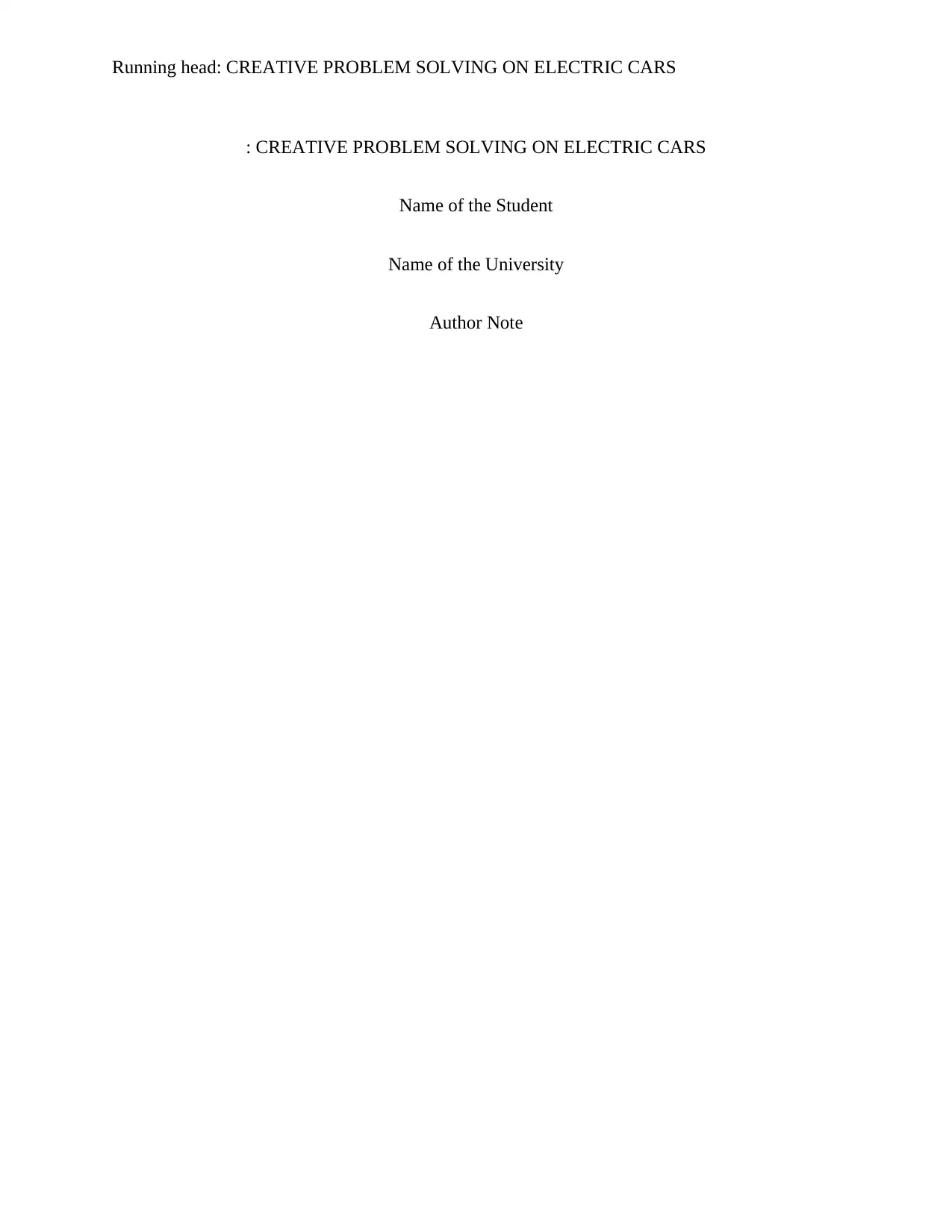
Running head: CREATIVE PROBLEM SOLVING ON ELECTRIC CARS
: CREATIVE PROBLEM SOLVING ON ELECTRIC CARS
Name of the Student
Name of the University
Author Note
: CREATIVE PROBLEM SOLVING ON ELECTRIC CARS
Name of the Student
Name of the University
Author Note
Paraphrase This Document
Need a fresh take? Get an instant paraphrase of this document with our AI Paraphraser
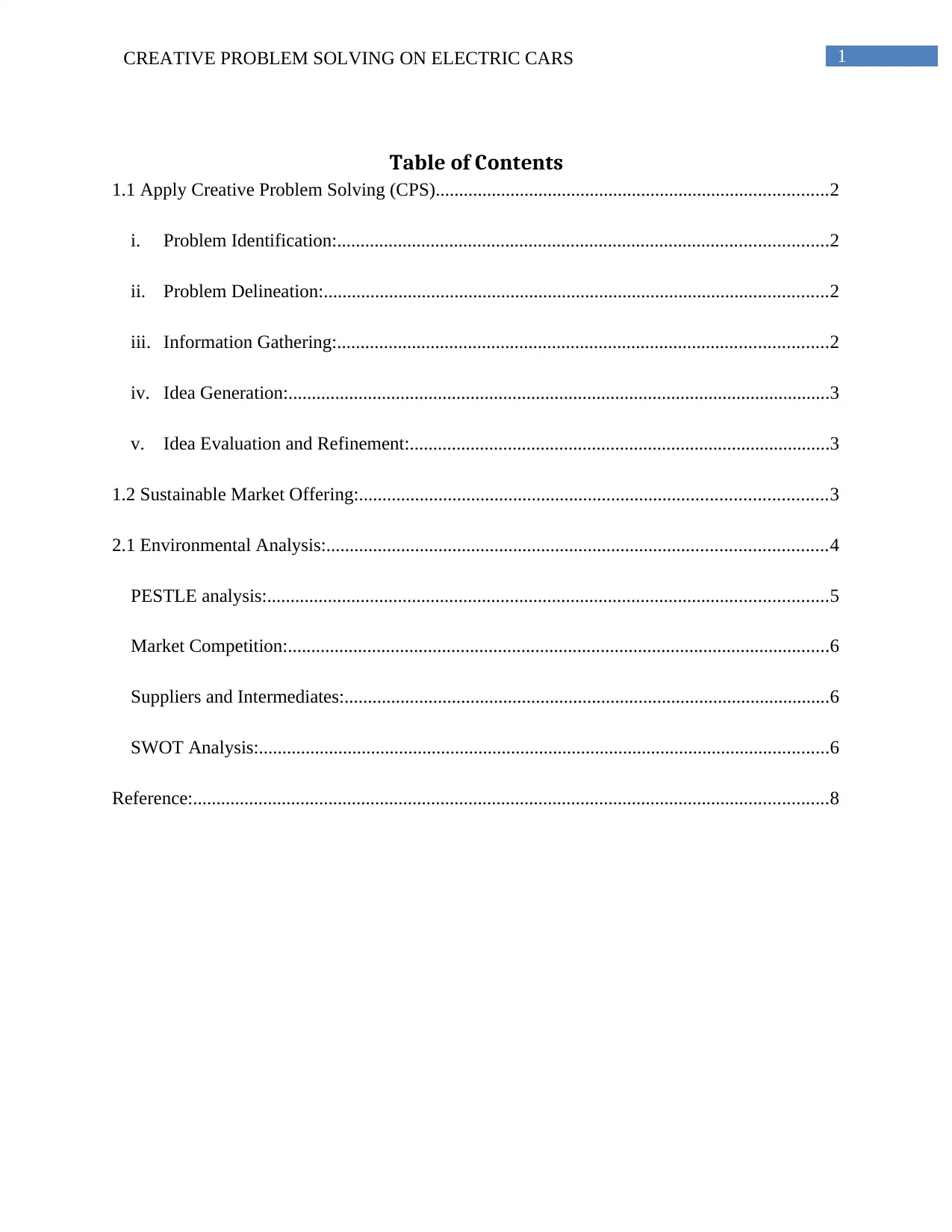
1CREATIVE PROBLEM SOLVING ON ELECTRIC CARS
Table of Contents
1.1 Apply Creative Problem Solving (CPS)....................................................................................2
i. Problem Identification:.........................................................................................................2
ii. Problem Delineation:............................................................................................................2
iii. Information Gathering:.........................................................................................................2
iv. Idea Generation:....................................................................................................................3
v. Idea Evaluation and Refinement:..........................................................................................3
1.2 Sustainable Market Offering:....................................................................................................3
2.1 Environmental Analysis:...........................................................................................................4
PESTLE analysis:........................................................................................................................5
Market Competition:....................................................................................................................6
Suppliers and Intermediates:........................................................................................................6
SWOT Analysis:..........................................................................................................................6
Reference:........................................................................................................................................8
Table of Contents
1.1 Apply Creative Problem Solving (CPS)....................................................................................2
i. Problem Identification:.........................................................................................................2
ii. Problem Delineation:............................................................................................................2
iii. Information Gathering:.........................................................................................................2
iv. Idea Generation:....................................................................................................................3
v. Idea Evaluation and Refinement:..........................................................................................3
1.2 Sustainable Market Offering:....................................................................................................3
2.1 Environmental Analysis:...........................................................................................................4
PESTLE analysis:........................................................................................................................5
Market Competition:....................................................................................................................6
Suppliers and Intermediates:........................................................................................................6
SWOT Analysis:..........................................................................................................................6
Reference:........................................................................................................................................8
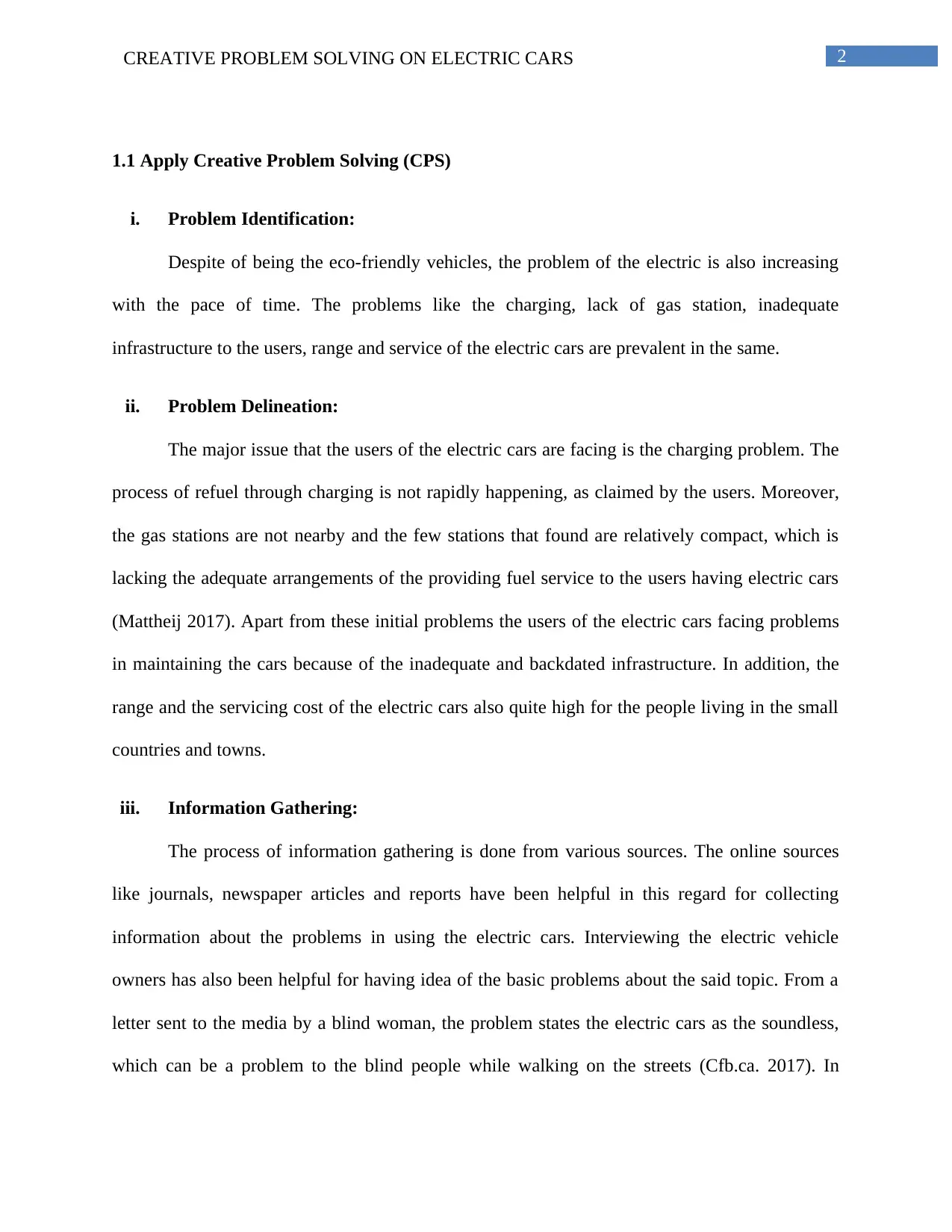
2CREATIVE PROBLEM SOLVING ON ELECTRIC CARS
1.1 Apply Creative Problem Solving (CPS)
i. Problem Identification:
Despite of being the eco-friendly vehicles, the problem of the electric is also increasing
with the pace of time. The problems like the charging, lack of gas station, inadequate
infrastructure to the users, range and service of the electric cars are prevalent in the same.
ii. Problem Delineation:
The major issue that the users of the electric cars are facing is the charging problem. The
process of refuel through charging is not rapidly happening, as claimed by the users. Moreover,
the gas stations are not nearby and the few stations that found are relatively compact, which is
lacking the adequate arrangements of the providing fuel service to the users having electric cars
(Mattheij 2017). Apart from these initial problems the users of the electric cars facing problems
in maintaining the cars because of the inadequate and backdated infrastructure. In addition, the
range and the servicing cost of the electric cars also quite high for the people living in the small
countries and towns.
iii. Information Gathering:
The process of information gathering is done from various sources. The online sources
like journals, newspaper articles and reports have been helpful in this regard for collecting
information about the problems in using the electric cars. Interviewing the electric vehicle
owners has also been helpful for having idea of the basic problems about the said topic. From a
letter sent to the media by a blind woman, the problem states the electric cars as the soundless,
which can be a problem to the blind people while walking on the streets (Cfb.ca. 2017). In
1.1 Apply Creative Problem Solving (CPS)
i. Problem Identification:
Despite of being the eco-friendly vehicles, the problem of the electric is also increasing
with the pace of time. The problems like the charging, lack of gas station, inadequate
infrastructure to the users, range and service of the electric cars are prevalent in the same.
ii. Problem Delineation:
The major issue that the users of the electric cars are facing is the charging problem. The
process of refuel through charging is not rapidly happening, as claimed by the users. Moreover,
the gas stations are not nearby and the few stations that found are relatively compact, which is
lacking the adequate arrangements of the providing fuel service to the users having electric cars
(Mattheij 2017). Apart from these initial problems the users of the electric cars facing problems
in maintaining the cars because of the inadequate and backdated infrastructure. In addition, the
range and the servicing cost of the electric cars also quite high for the people living in the small
countries and towns.
iii. Information Gathering:
The process of information gathering is done from various sources. The online sources
like journals, newspaper articles and reports have been helpful in this regard for collecting
information about the problems in using the electric cars. Interviewing the electric vehicle
owners has also been helpful for having idea of the basic problems about the said topic. From a
letter sent to the media by a blind woman, the problem states the electric cars as the soundless,
which can be a problem to the blind people while walking on the streets (Cfb.ca. 2017). In
⊘ This is a preview!⊘
Do you want full access?
Subscribe today to unlock all pages.

Trusted by 1+ million students worldwide
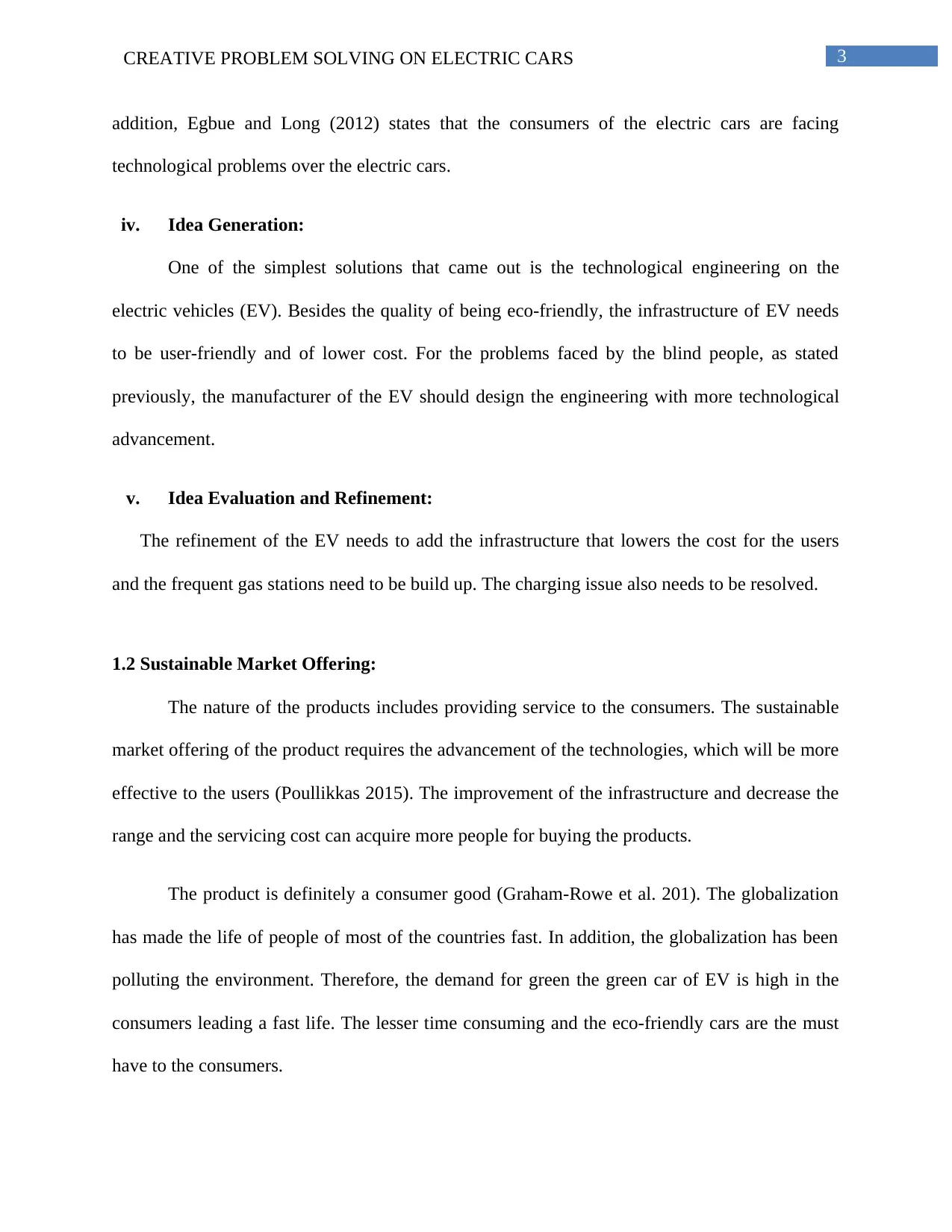
3CREATIVE PROBLEM SOLVING ON ELECTRIC CARS
addition, Egbue and Long (2012) states that the consumers of the electric cars are facing
technological problems over the electric cars.
iv. Idea Generation:
One of the simplest solutions that came out is the technological engineering on the
electric vehicles (EV). Besides the quality of being eco-friendly, the infrastructure of EV needs
to be user-friendly and of lower cost. For the problems faced by the blind people, as stated
previously, the manufacturer of the EV should design the engineering with more technological
advancement.
v. Idea Evaluation and Refinement:
The refinement of the EV needs to add the infrastructure that lowers the cost for the users
and the frequent gas stations need to be build up. The charging issue also needs to be resolved.
1.2 Sustainable Market Offering:
The nature of the products includes providing service to the consumers. The sustainable
market offering of the product requires the advancement of the technologies, which will be more
effective to the users (Poullikkas 2015). The improvement of the infrastructure and decrease the
range and the servicing cost can acquire more people for buying the products.
The product is definitely a consumer good (Graham-Rowe et al. 201). The globalization
has made the life of people of most of the countries fast. In addition, the globalization has been
polluting the environment. Therefore, the demand for green the green car of EV is high in the
consumers leading a fast life. The lesser time consuming and the eco-friendly cars are the must
have to the consumers.
addition, Egbue and Long (2012) states that the consumers of the electric cars are facing
technological problems over the electric cars.
iv. Idea Generation:
One of the simplest solutions that came out is the technological engineering on the
electric vehicles (EV). Besides the quality of being eco-friendly, the infrastructure of EV needs
to be user-friendly and of lower cost. For the problems faced by the blind people, as stated
previously, the manufacturer of the EV should design the engineering with more technological
advancement.
v. Idea Evaluation and Refinement:
The refinement of the EV needs to add the infrastructure that lowers the cost for the users
and the frequent gas stations need to be build up. The charging issue also needs to be resolved.
1.2 Sustainable Market Offering:
The nature of the products includes providing service to the consumers. The sustainable
market offering of the product requires the advancement of the technologies, which will be more
effective to the users (Poullikkas 2015). The improvement of the infrastructure and decrease the
range and the servicing cost can acquire more people for buying the products.
The product is definitely a consumer good (Graham-Rowe et al. 201). The globalization
has made the life of people of most of the countries fast. In addition, the globalization has been
polluting the environment. Therefore, the demand for green the green car of EV is high in the
consumers leading a fast life. The lesser time consuming and the eco-friendly cars are the must
have to the consumers.
Paraphrase This Document
Need a fresh take? Get an instant paraphrase of this document with our AI Paraphraser
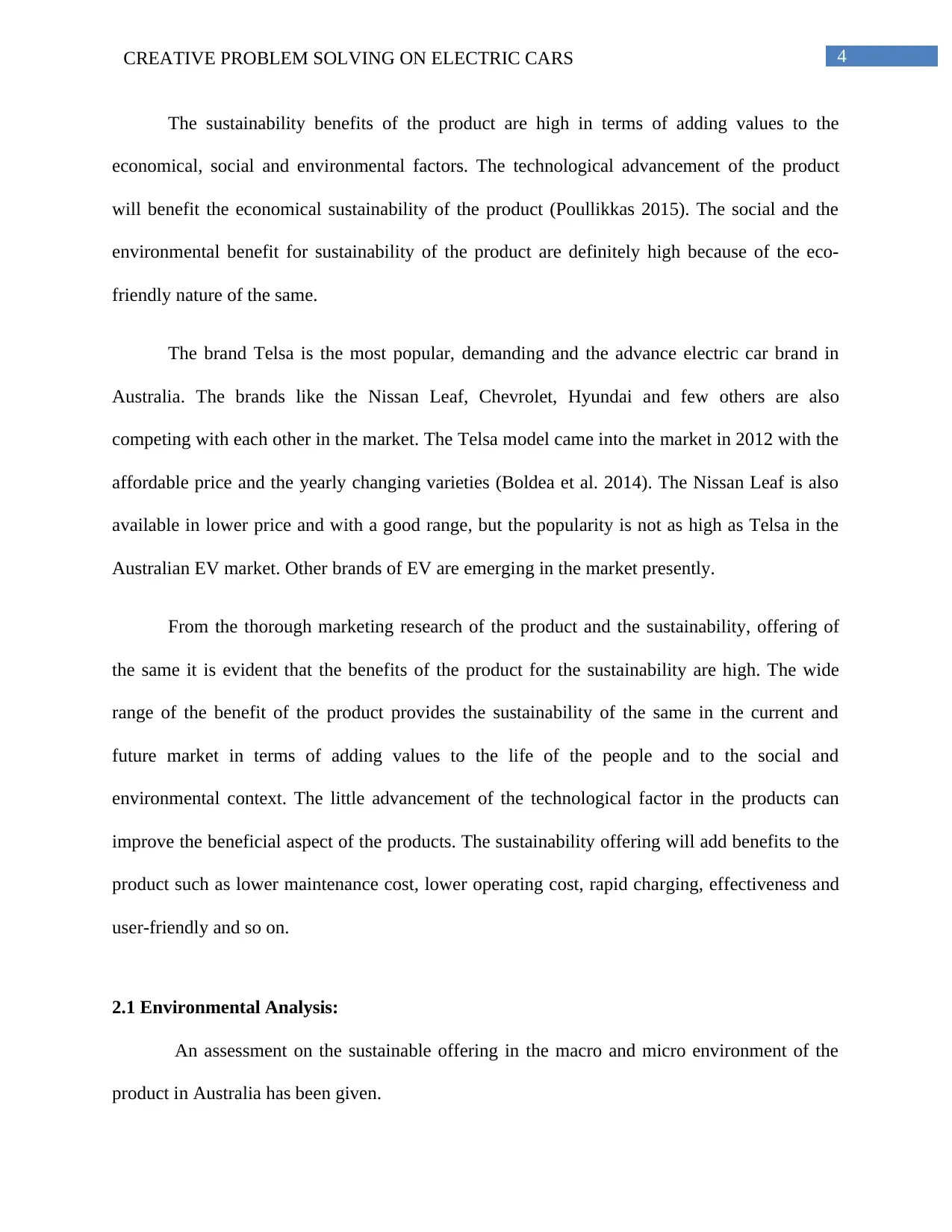
4CREATIVE PROBLEM SOLVING ON ELECTRIC CARS
The sustainability benefits of the product are high in terms of adding values to the
economical, social and environmental factors. The technological advancement of the product
will benefit the economical sustainability of the product (Poullikkas 2015). The social and the
environmental benefit for sustainability of the product are definitely high because of the eco-
friendly nature of the same.
The brand Telsa is the most popular, demanding and the advance electric car brand in
Australia. The brands like the Nissan Leaf, Chevrolet, Hyundai and few others are also
competing with each other in the market. The Telsa model came into the market in 2012 with the
affordable price and the yearly changing varieties (Boldea et al. 2014). The Nissan Leaf is also
available in lower price and with a good range, but the popularity is not as high as Telsa in the
Australian EV market. Other brands of EV are emerging in the market presently.
From the thorough marketing research of the product and the sustainability, offering of
the same it is evident that the benefits of the product for the sustainability are high. The wide
range of the benefit of the product provides the sustainability of the same in the current and
future market in terms of adding values to the life of the people and to the social and
environmental context. The little advancement of the technological factor in the products can
improve the beneficial aspect of the products. The sustainability offering will add benefits to the
product such as lower maintenance cost, lower operating cost, rapid charging, effectiveness and
user-friendly and so on.
2.1 Environmental Analysis:
An assessment on the sustainable offering in the macro and micro environment of the
product in Australia has been given.
The sustainability benefits of the product are high in terms of adding values to the
economical, social and environmental factors. The technological advancement of the product
will benefit the economical sustainability of the product (Poullikkas 2015). The social and the
environmental benefit for sustainability of the product are definitely high because of the eco-
friendly nature of the same.
The brand Telsa is the most popular, demanding and the advance electric car brand in
Australia. The brands like the Nissan Leaf, Chevrolet, Hyundai and few others are also
competing with each other in the market. The Telsa model came into the market in 2012 with the
affordable price and the yearly changing varieties (Boldea et al. 2014). The Nissan Leaf is also
available in lower price and with a good range, but the popularity is not as high as Telsa in the
Australian EV market. Other brands of EV are emerging in the market presently.
From the thorough marketing research of the product and the sustainability, offering of
the same it is evident that the benefits of the product for the sustainability are high. The wide
range of the benefit of the product provides the sustainability of the same in the current and
future market in terms of adding values to the life of the people and to the social and
environmental context. The little advancement of the technological factor in the products can
improve the beneficial aspect of the products. The sustainability offering will add benefits to the
product such as lower maintenance cost, lower operating cost, rapid charging, effectiveness and
user-friendly and so on.
2.1 Environmental Analysis:
An assessment on the sustainable offering in the macro and micro environment of the
product in Australia has been given.
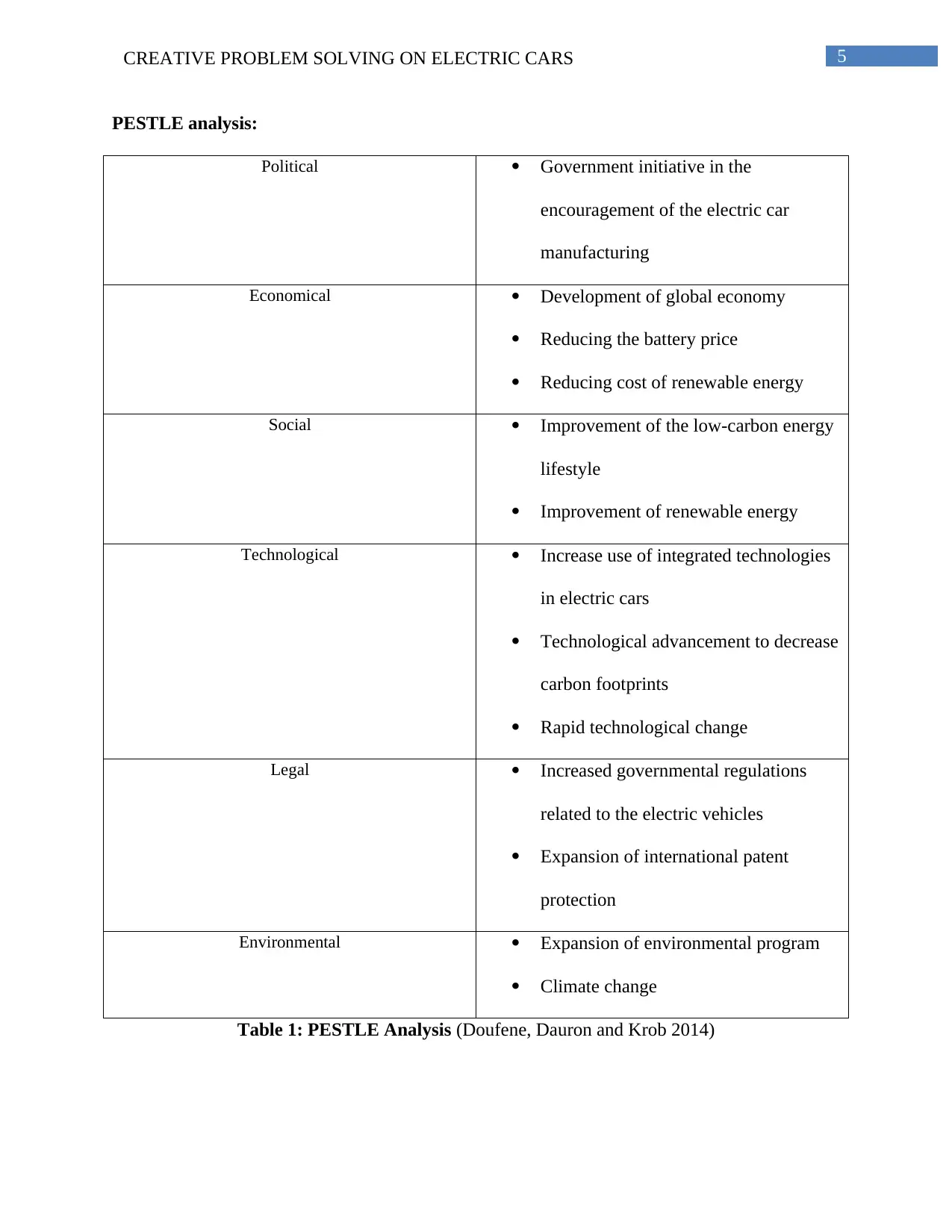
5CREATIVE PROBLEM SOLVING ON ELECTRIC CARS
PESTLE analysis:
Political Government initiative in the
encouragement of the electric car
manufacturing
Economical Development of global economy
Reducing the battery price
Reducing cost of renewable energy
Social Improvement of the low-carbon energy
lifestyle
Improvement of renewable energy
Technological Increase use of integrated technologies
in electric cars
Technological advancement to decrease
carbon footprints
Rapid technological change
Legal Increased governmental regulations
related to the electric vehicles
Expansion of international patent
protection
Environmental Expansion of environmental program
Climate change
Table 1: PESTLE Analysis (Doufene, Dauron and Krob 2014)
PESTLE analysis:
Political Government initiative in the
encouragement of the electric car
manufacturing
Economical Development of global economy
Reducing the battery price
Reducing cost of renewable energy
Social Improvement of the low-carbon energy
lifestyle
Improvement of renewable energy
Technological Increase use of integrated technologies
in electric cars
Technological advancement to decrease
carbon footprints
Rapid technological change
Legal Increased governmental regulations
related to the electric vehicles
Expansion of international patent
protection
Environmental Expansion of environmental program
Climate change
Table 1: PESTLE Analysis (Doufene, Dauron and Krob 2014)
⊘ This is a preview!⊘
Do you want full access?
Subscribe today to unlock all pages.

Trusted by 1+ million students worldwide
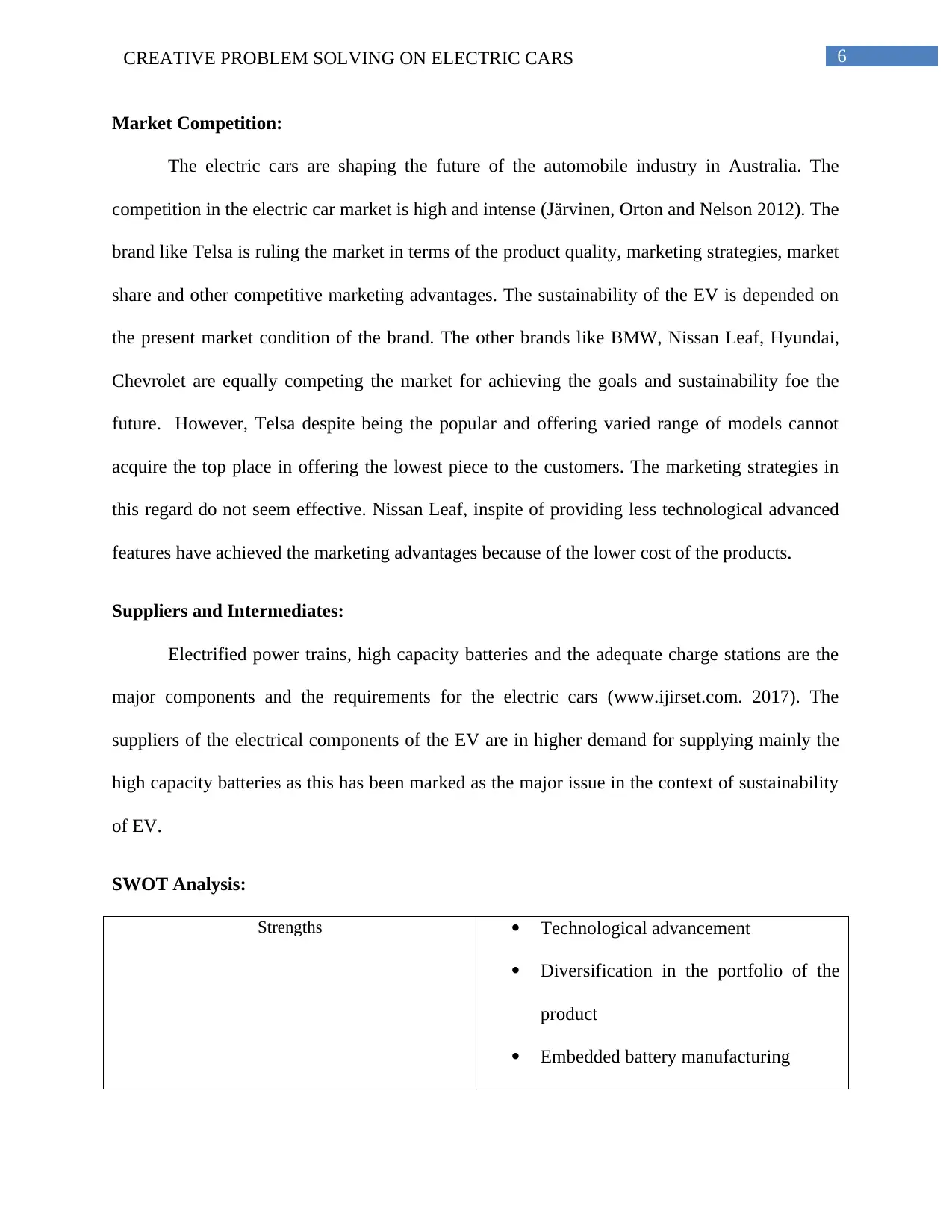
6CREATIVE PROBLEM SOLVING ON ELECTRIC CARS
Market Competition:
The electric cars are shaping the future of the automobile industry in Australia. The
competition in the electric car market is high and intense (Järvinen, Orton and Nelson 2012). The
brand like Telsa is ruling the market in terms of the product quality, marketing strategies, market
share and other competitive marketing advantages. The sustainability of the EV is depended on
the present market condition of the brand. The other brands like BMW, Nissan Leaf, Hyundai,
Chevrolet are equally competing the market for achieving the goals and sustainability foe the
future. However, Telsa despite being the popular and offering varied range of models cannot
acquire the top place in offering the lowest piece to the customers. The marketing strategies in
this regard do not seem effective. Nissan Leaf, inspite of providing less technological advanced
features have achieved the marketing advantages because of the lower cost of the products.
Suppliers and Intermediates:
Electrified power trains, high capacity batteries and the adequate charge stations are the
major components and the requirements for the electric cars (www.ijirset.com. 2017). The
suppliers of the electrical components of the EV are in higher demand for supplying mainly the
high capacity batteries as this has been marked as the major issue in the context of sustainability
of EV.
SWOT Analysis:
Strengths Technological advancement
Diversification in the portfolio of the
product
Embedded battery manufacturing
Market Competition:
The electric cars are shaping the future of the automobile industry in Australia. The
competition in the electric car market is high and intense (Järvinen, Orton and Nelson 2012). The
brand like Telsa is ruling the market in terms of the product quality, marketing strategies, market
share and other competitive marketing advantages. The sustainability of the EV is depended on
the present market condition of the brand. The other brands like BMW, Nissan Leaf, Hyundai,
Chevrolet are equally competing the market for achieving the goals and sustainability foe the
future. However, Telsa despite being the popular and offering varied range of models cannot
acquire the top place in offering the lowest piece to the customers. The marketing strategies in
this regard do not seem effective. Nissan Leaf, inspite of providing less technological advanced
features have achieved the marketing advantages because of the lower cost of the products.
Suppliers and Intermediates:
Electrified power trains, high capacity batteries and the adequate charge stations are the
major components and the requirements for the electric cars (www.ijirset.com. 2017). The
suppliers of the electrical components of the EV are in higher demand for supplying mainly the
high capacity batteries as this has been marked as the major issue in the context of sustainability
of EV.
SWOT Analysis:
Strengths Technological advancement
Diversification in the portfolio of the
product
Embedded battery manufacturing
Paraphrase This Document
Need a fresh take? Get an instant paraphrase of this document with our AI Paraphraser
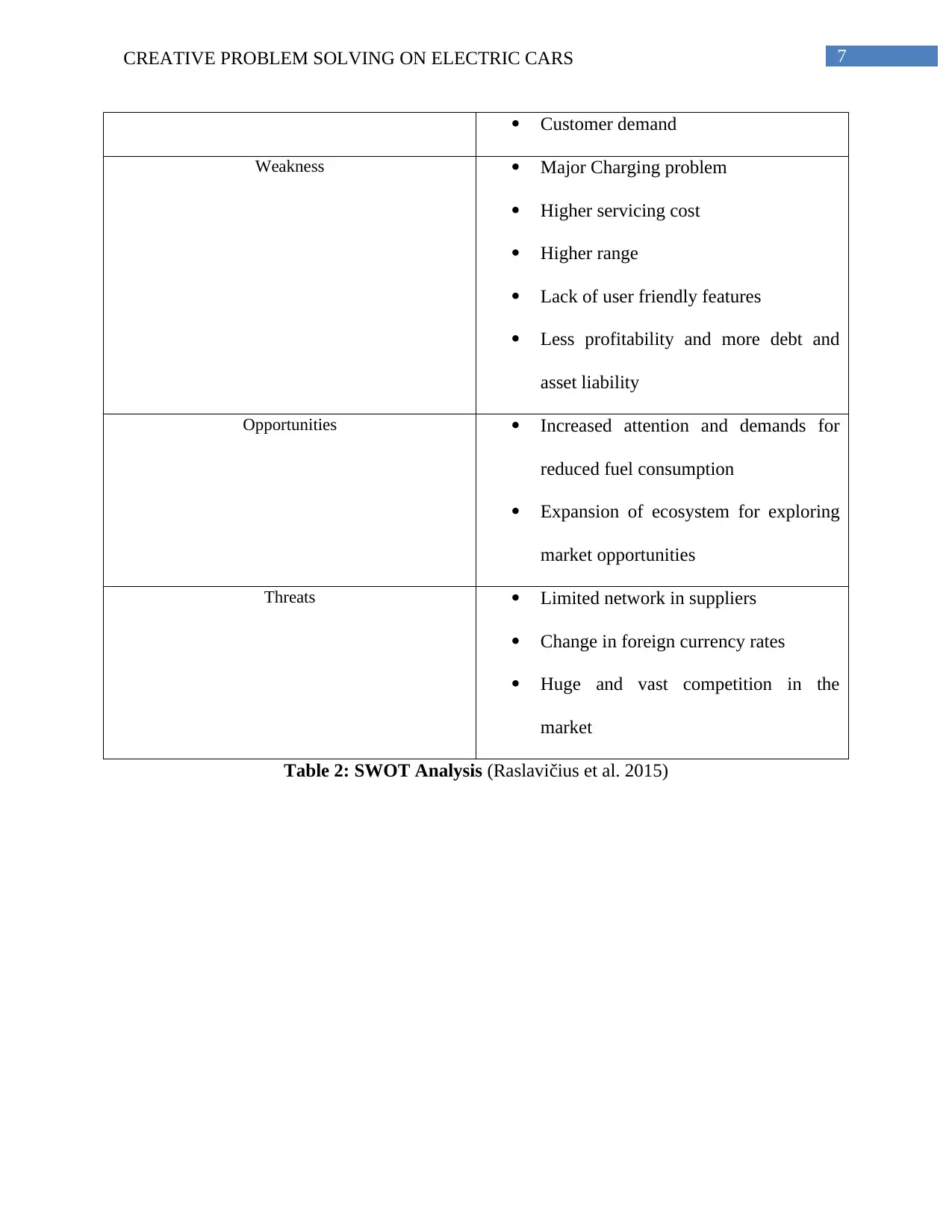
7CREATIVE PROBLEM SOLVING ON ELECTRIC CARS
Customer demand
Weakness Major Charging problem
Higher servicing cost
Higher range
Lack of user friendly features
Less profitability and more debt and
asset liability
Opportunities Increased attention and demands for
reduced fuel consumption
Expansion of ecosystem for exploring
market opportunities
Threats Limited network in suppliers
Change in foreign currency rates
Huge and vast competition in the
market
Table 2: SWOT Analysis (Raslavičius et al. 2015)
Customer demand
Weakness Major Charging problem
Higher servicing cost
Higher range
Lack of user friendly features
Less profitability and more debt and
asset liability
Opportunities Increased attention and demands for
reduced fuel consumption
Expansion of ecosystem for exploring
market opportunities
Threats Limited network in suppliers
Change in foreign currency rates
Huge and vast competition in the
market
Table 2: SWOT Analysis (Raslavičius et al. 2015)
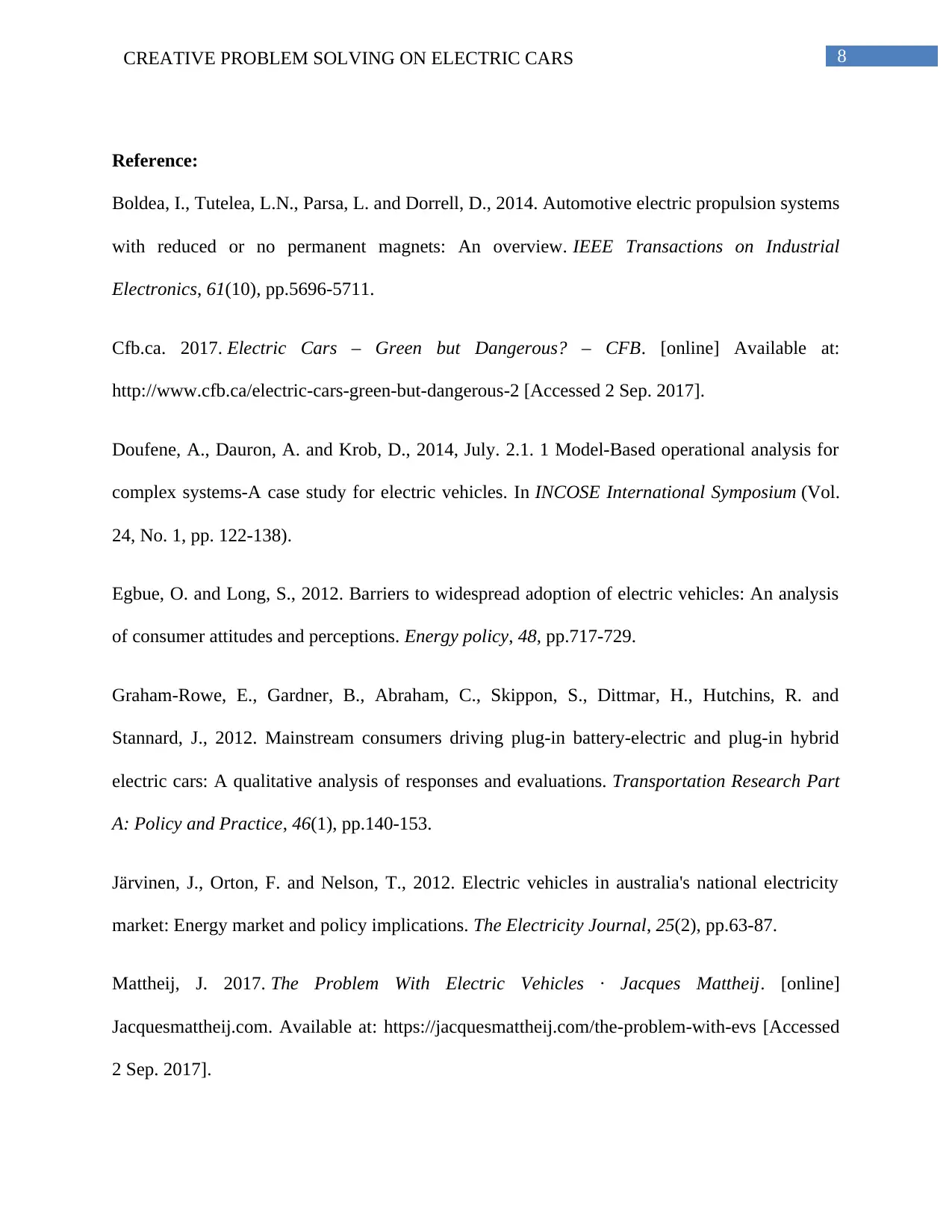
8CREATIVE PROBLEM SOLVING ON ELECTRIC CARS
Reference:
Boldea, I., Tutelea, L.N., Parsa, L. and Dorrell, D., 2014. Automotive electric propulsion systems
with reduced or no permanent magnets: An overview. IEEE Transactions on Industrial
Electronics, 61(10), pp.5696-5711.
Cfb.ca. 2017. Electric Cars – Green but Dangerous? – CFB. [online] Available at:
http://www.cfb.ca/electric-cars-green-but-dangerous-2 [Accessed 2 Sep. 2017].
Doufene, A., Dauron, A. and Krob, D., 2014, July. 2.1. 1 Model‐Based operational analysis for
complex systems‐A case study for electric vehicles. In INCOSE International Symposium (Vol.
24, No. 1, pp. 122-138).
Egbue, O. and Long, S., 2012. Barriers to widespread adoption of electric vehicles: An analysis
of consumer attitudes and perceptions. Energy policy, 48, pp.717-729.
Graham-Rowe, E., Gardner, B., Abraham, C., Skippon, S., Dittmar, H., Hutchins, R. and
Stannard, J., 2012. Mainstream consumers driving plug-in battery-electric and plug-in hybrid
electric cars: A qualitative analysis of responses and evaluations. Transportation Research Part
A: Policy and Practice, 46(1), pp.140-153.
Järvinen, J., Orton, F. and Nelson, T., 2012. Electric vehicles in australia's national electricity
market: Energy market and policy implications. The Electricity Journal, 25(2), pp.63-87.
Mattheij, J. 2017. The Problem With Electric Vehicles · Jacques Mattheij. [online]
Jacquesmattheij.com. Available at: https://jacquesmattheij.com/the-problem-with-evs [Accessed
2 Sep. 2017].
Reference:
Boldea, I., Tutelea, L.N., Parsa, L. and Dorrell, D., 2014. Automotive electric propulsion systems
with reduced or no permanent magnets: An overview. IEEE Transactions on Industrial
Electronics, 61(10), pp.5696-5711.
Cfb.ca. 2017. Electric Cars – Green but Dangerous? – CFB. [online] Available at:
http://www.cfb.ca/electric-cars-green-but-dangerous-2 [Accessed 2 Sep. 2017].
Doufene, A., Dauron, A. and Krob, D., 2014, July. 2.1. 1 Model‐Based operational analysis for
complex systems‐A case study for electric vehicles. In INCOSE International Symposium (Vol.
24, No. 1, pp. 122-138).
Egbue, O. and Long, S., 2012. Barriers to widespread adoption of electric vehicles: An analysis
of consumer attitudes and perceptions. Energy policy, 48, pp.717-729.
Graham-Rowe, E., Gardner, B., Abraham, C., Skippon, S., Dittmar, H., Hutchins, R. and
Stannard, J., 2012. Mainstream consumers driving plug-in battery-electric and plug-in hybrid
electric cars: A qualitative analysis of responses and evaluations. Transportation Research Part
A: Policy and Practice, 46(1), pp.140-153.
Järvinen, J., Orton, F. and Nelson, T., 2012. Electric vehicles in australia's national electricity
market: Energy market and policy implications. The Electricity Journal, 25(2), pp.63-87.
Mattheij, J. 2017. The Problem With Electric Vehicles · Jacques Mattheij. [online]
Jacquesmattheij.com. Available at: https://jacquesmattheij.com/the-problem-with-evs [Accessed
2 Sep. 2017].
⊘ This is a preview!⊘
Do you want full access?
Subscribe today to unlock all pages.

Trusted by 1+ million students worldwide
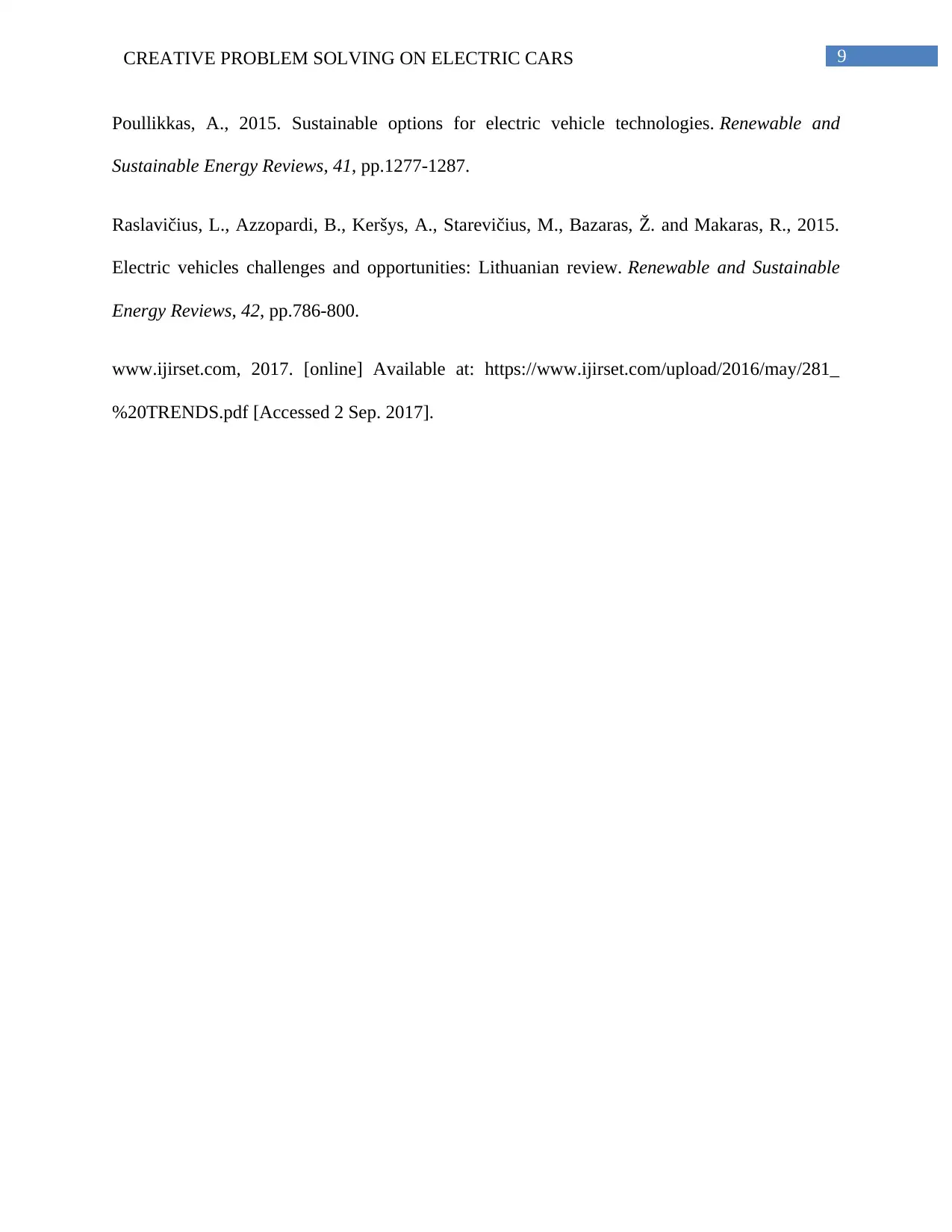
9CREATIVE PROBLEM SOLVING ON ELECTRIC CARS
Poullikkas, A., 2015. Sustainable options for electric vehicle technologies. Renewable and
Sustainable Energy Reviews, 41, pp.1277-1287.
Raslavičius, L., Azzopardi, B., Keršys, A., Starevičius, M., Bazaras, Ž. and Makaras, R., 2015.
Electric vehicles challenges and opportunities: Lithuanian review. Renewable and Sustainable
Energy Reviews, 42, pp.786-800.
www.ijirset.com, 2017. [online] Available at: https://www.ijirset.com/upload/2016/may/281_
%20TRENDS.pdf [Accessed 2 Sep. 2017].
Poullikkas, A., 2015. Sustainable options for electric vehicle technologies. Renewable and
Sustainable Energy Reviews, 41, pp.1277-1287.
Raslavičius, L., Azzopardi, B., Keršys, A., Starevičius, M., Bazaras, Ž. and Makaras, R., 2015.
Electric vehicles challenges and opportunities: Lithuanian review. Renewable and Sustainable
Energy Reviews, 42, pp.786-800.
www.ijirset.com, 2017. [online] Available at: https://www.ijirset.com/upload/2016/may/281_
%20TRENDS.pdf [Accessed 2 Sep. 2017].
1 out of 10
Related Documents
Your All-in-One AI-Powered Toolkit for Academic Success.
+13062052269
info@desklib.com
Available 24*7 on WhatsApp / Email
![[object Object]](/_next/static/media/star-bottom.7253800d.svg)
Unlock your academic potential
Copyright © 2020–2025 A2Z Services. All Rights Reserved. Developed and managed by ZUCOL.




